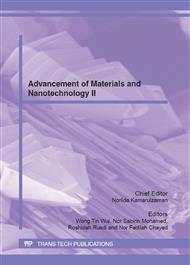p.182
p.185
p.190
p.195
p.199
p.204
p.209
p.214
p.223
Synthesis and Electrochemical Behaviour of LiMn(2-x)ZnxO4 Cathode Materials
Abstract:
Lithium manganese oxide, LiMn2O4, is said to be the most promising cathode material to replace the present day ones used in commercial Li-ion batteries. However, it suffers from capacity fading. One of the ways to improve this material is by substituting some of the Mn atoms with some other metal or transition metal element to stabilize the material. Spinel type lithium manganese zinc oxide, LiMn(2-x)Zn\xO4 (x= 0.1, 0.2, 0.3, 0.4, 0.5) were prepared by sol-gel method. The compounds have a potential to improve pure LiMn2O4 performance. This method involves the mixing of acetates of metals and dissolved in absolute ethanol followed by the addition of tartaric acid. Tartaric acid acts as a gelling agent of the metal complexes and the compound was dried at low temperature to obtain the precursor of LiMn(2-x)ZnxO4. The synthesized product was annealed at a temperature of 850 oC for about 24 hour and X-Ray Diffraction (XRD) and Scanning Electron Microscopy (SEM) were done. Battery fabrications using the cathode materials were done using a non-aqueous electrolyte and Li metal as the anode. From charge-discharge studies, it was found that LiMn1.9Zn0.1O4 has better discharge capacity.
Info:
Periodical:
Pages:
199-203
Citation:
Online since:
July 2012
Price:
Сopyright:
© 2012 Trans Tech Publications Ltd. All Rights Reserved
Share:
Citation:


